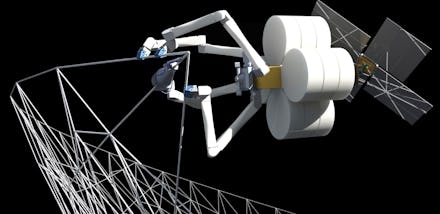These Robot Spiders Could Someday Build a Death Star in Space

Thanks to a NASA-funded project to use spider-like drones as in-space construction workers, the day of building a real-life Death Star could be approaching.
SpiderFab, a technology developed by Washington state-based technology firm Tethers Unlimited, uses a 3-D-printing robot to fabricate carbon-fiber construction pieces, like structural tubing and walls, and then bond the elements together.
Basically, it's a one-robot construction crew, able to produce everything needed to create a finished product using only carbon fiber and its arachnid-like arms. One arm, built with a fabricating "spinneret," makes the raw pieces which the other arms fuse together to create trusses, crawling around the structure to create a carbon-fiber web.
The applications: While Robert Hoyt, Tethers Unlimited's CEO, says SpiderFab could be used for building smaller elements like radio antennas and solar elements, the possibilities for creating real, sustainable living options (like a Death Star) are the most promising — and may be the most compelling for NASA's further explorations in space.
"Our really long-team objective for all of this work is to eventually enable the use of in-site resources to construct the infrastructure in space needed to support humanity's expansion throughout the solar system," Hoyt said during a presentation with NASA's Future In-Space Operations group, according to Space.com.
The problem with our current method of getting things into space, whether it's something as small as a CubeSat or large inflatable spacecraft used for settling alien planets, is that they need to be attached to some sort of launcher. The larger the object, the more powerful the launcher needs to be. It was only this year that a rocket large enough to get us to Mars — a pretty nearby destination, considering the size of the solar system — was put through its paces.
"It's a very expensive and time-consuming process, and also the size of systems is somewhat limited by the size of the deployables that are possible to fold up and fit within a launch shroud," Hoyt said, according to Space.com.
His simple example of the technology's use is a "starshade," a giant structure that blocks the glare of stars so in-orbit telescopes can capture clearer pictures of planets and determine if they're habitable.
But as technology starts to catch up to science fiction, considering what could be built without size restrictions opens up a lot of "what ifs." In 2012, a group of Lehigh University economics students took a theoretical look at what it would actually take, in resources both monetary and elemental, to build the Galactic Empire's greatest super-weapon, not out of steel, but with carbon fiber, the building block of all SpiderFab construction.
Without the need to launch a sphere 140 kilometers in diameter from the surface, through the atmosphere and into orbit, the only real requirement for what a SpiderFab bot can build is how much carbon fiber can be launched to the robots — which is undoubtedly less than the 1.08x10^15 (or 1,080,000,000,000,000) tons of steel the Lehigh students estimated was needed.
Since the threat of hostile alien life isn't quite the global space community's major concern (yet), it's probably safe to say the first mega-complex built in space would be a station to orbit a planet, and not a massive, Sith-corrupted killing machine. But with the ability to build objects uninhibited by size restrictions, there's no reason the next off-world habitat couldn't be a massive, floating sphere, carrying an interstellar community bent on exploring the solar system.